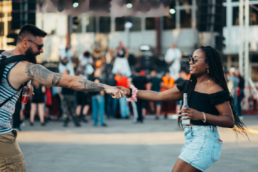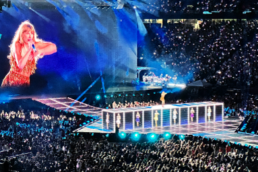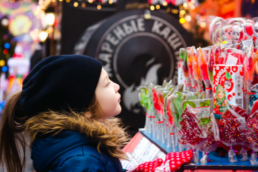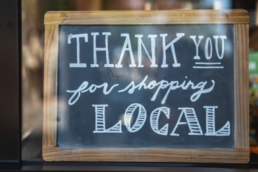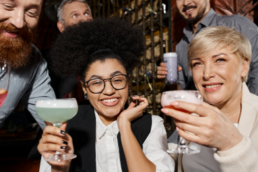As we explored in the last placemaking trends report, the car is king in U.S. culture. With the impacts of COVID-19 and subsequent shifts in consumer behavior, big businesses are not wasting time on preparing for the long haul. Whether it’s months or years before this pandemic subsides (vaccine or herd immunity aside), there’s still a very real chance that another biological threat could befall us at any time. And considering the economic effects of the last six months, major players in fast food, convenience and retail are all preparing for a fruitful future that puts the automobile front and center of their strategies.
DEALS ON WHEELS
Major restaurant chains, retailers, grocery and convenience stores have rapidly reacted to the current climate by reconfiguring their business models to focus on the perceived safety of the automobile; limiting in-store and in-person interactions, encouraging adoption and usage of proprietary apps, developing contactless payment models, QR code-based menus, and heavying up on curbside pick-up and delivery channels all hinge on automobiles.
Burger King, Shake Shake, Starbucks and Taco Bell have all announced new plans to leverage the increased demand for drive-thru and curbside pick-up, in addition to migrating consumers to use their apps for expediency and convenience. Additional drive-thru lanes, frictionless digital payment and load-balancing the increase in automobiles (both owned and ride-share delivery services acting as intermediaries for orders) are common themes among fast food restaurants. Due to the pandemic, most of these businesses have seen in-store dining decrease, and for some, evaporate entirely. Meanwhile, drive-thru sales have exploded exponentially over the past six months.
THE CAR IS KING FOR BURGERS & FRIES

Burger King is pursuing two new architectural models to tap into demand, and reduce in-store interactions (to an extent), according to Fast Company.
The first model (shown below) takes a cue from a 2012 Starbucks small footprint concept that reduces the location’s internal size by up to 60% and encourages customers to drive up, walk up or even be served outdoors “car hop” style under a canopy of solar panels (think Sonic).

In the second BK model, the store is a stacked two-story unit, again reducing the businesses footprint, but it still contains a dining room – upstairs! This allows for increased auto lanes for ordering and fulfillment, but also allows lures some customers away from curbside to dine-in. As you probably know, the longer the line is outside of a restaurant, the less likely customers are to pull in and wait in the drive-thru, so this uncanny design maximizes both drive-thru and in-store orders and revenues.
With over 7,000 burger Locations in the U.S., and nearly all of them franchisee owned, it may take a few years before your local location gets a mobile makeover. Franchisees foot the bill for remodels and retrofits, but the revenue potential is realistic with the new concepts.
Josh Kobza, COO of Restaurant Brands International (Burger King’s parent company) was quoted by Fast Company as saying, “We’d already seen a pretty consistent trend into a higher mix of drive-through, even pre-2020. That’s increased further this year, but I suspect that will persist to some extent into the future. We’d also seen growth in delivery, but I think [because of COVID-19,] we probably jumped forward a couple of years in terms of the adoption curve of delivery. That permanently changes the [design] of restaurants.”
Additionally, Burger King is considering Amazon style lockers at locations with a dynamic access codes, so you can order on the app, grab your food and go without coming face-to-face with an actual person. This form of contactless commerce is likely to be adopted by more companies as consumers continue to adapt to “Millennial-preferred” models of decreased human interaction for “menial” interpersonal engagements. (See Moxy Hotels for instance)
DRIVE-THRU DRIVES PROFITS
According to market researchers at NPD Group, “Drive-thru restaurant visits increased by +26% in the April, May, and June quarter and represented 42% of all restaurant visits. In July when more restaurants were reopened, drive-thru visits still increased by +13%, the highest visit increase among the service modes of on-premises, carry-out, and delivery…”
NPD food industry advisor David Portalatin states that, “Drive-thru operations are delivering a high ROI during the pandemic, offering convenience, speed, and the comfort of social distance to consumers using them,” as well as, “Fast casual and traditional quick service chains have already announced expansion plans for their drive-thru operations, and we will hear more chains doing the same. Drive-thru and other off-premises operations will be a major part of the U.S. restaurant industry’s recovery and future.”
This position is also supported by industry leaders such as Taco Bell and Shake Shack.
PLEASE RING BELL FOR SERVICE

Yum Brands-owned Taco Bell has been making big waves lately with new menu changes, however some of the biggest long-term changes will appear in their locations’ physical set-up and design. Anticipated changes include dual drive-thru lanes and parking spots dedicated to contactless pick-up. The design, called “Go Mobile” also features shelves used to easily pick-up mobile orders, as well as new technology that load-balances kitchen staff and customer demand, telling both where and how the fastest and most convenient way to make, serve and pick up food.
According to a CNBC article, Taco Bell served an additional 4.8 million cars in Q2 of this year, compared to Y-O-Y statistics. While the company reported an overall 8% decline in sales during this period, it’s confident the new Go Mobile design will help counter that decline and position franchised locations for better success moving forward.
“We have a lot of franchisees interested in expanding drive-thru capacity,” according Taco Bell Global Chief Operating Officer Mike Grams. And according to QSRWeb, Taco Bell intends to serve one billion customers at its drive-thru windows between March 2020 – March 2021.

WHAT’S SHAKIN’?

In a similar fashion, Shake Shack shook out the first of its new concepts in May of this year, featuring now-familiar features like walk up windows, and expanded drive-thru lanes, including one dedicated to app pick-up orders, with curbside becoming a permanent feature. Banking of the future of contactless fulfillment, the company plans for at least eight of its locations to feature the new design by the end of the year.
WAWA WHAT?

For residents of the Mid-Atlantic, PA-based Wawa stores (named for a Native American word for the Canada Goose – often seen migrating though the region seasonally), is a fan favorite for gasoline, coffee, cigarettes, convenience store staples and its ever-expanding kitchens serving up thousands of options of hoagies and hot foods. Wawa pioneered the use of consumer touch screen kiosks for ordering years ago, and in following its trendsetting business practices, the company announced a new car-centric concept of the “Wawa drive-thru” earlier this year.

Wawa’s director of construction Terri Micklin is quoted as saying, “Wawa continues to test new store concepts with this latest drive-thru format, providing an opportunity for our customers to still experience and enjoy their favorite Wawa products while remaining inside their vehicle…it is critical to provide new ways to access Wawa, increase convenience and provide new options for service.“
The trendy content kings at Thrillest reported back in August on the first Wawa drive-thru, an 1,850 square foot store location, due to open in Falls Township (near Levittown, PA) later this year. Wawa is testing operations and workflow for this concept at a drive-thru window at one of its Burlington County, NJ locations now and will apply lessons learned to the new format.
CURBSIDE PICKUP PICKS UP
The pandemic has also pushed a massive surge in curbside pick up, and not just for restaurants. Retailers nationwide saw explosive growth in curbside pick up for anything and everything people used to shop for indoors. From groceries to household essentials, the trend in ordering ahead and popping by your nearest purveyor picked up speed (and returns in revenue) since the pandemic has shuttered many at home, except the procurement of necessities.
According to USA Today, Target’s digital sales shot up 195% in Q2 of this year, with the retailer leaning into this trend and investing heavily in enhancing the order-ahead revenue opportunities. Target added fresh and frozen grocery items to 1,500 stores this summer and expanded the number of parking spaces for Drive Up at many stores.
Users of Target’s Drive Up service place a digital order from the Target app, drive to their local store and park in specially-reserved spots, and a team member delivers it to their car within a matter of minutes. Seamless, frictionless and nearly contactless, these types of services are changing the game for retail. Target reported that its Drive Up curbside pickup grew an “astonishing 730%” over the same quarter in 2019. Bullseye!
Walmart saw an increase of 74% in online sales in Q1 and 97% in digital orders in Q2. While not at the same level of growth as Target, Walmart is also competing for grocery dollars in a big way against more traditional grocers, and according to The Motely Fool, this accounts for about two-thirds of its online sales for the first quarter. Furthering this trend, Walmart CFO Brett Biggs said it saw a 300% increase year-over-year at the peak of Q1/20.
Walmart is in a unique position; competing with both broad retailers (like Amazon and Target), as well as traditional grocery stores. National grocery big-hitter Kroger is leaning into e-commerce in a big way by integrating their digital offerings and allowing consumers to easily toggle between shipping, store delivery and curbside services. And to compete, Walmart has doubled the number of sellers on its marketplace to 50,000, per GroceryDive.com.
Integrated market strategies that rely heavily on consumer use of apps, delivery and curbside, not only offer opportunities to make up for displaced in-store consumers, it also offers these retailers rich data history for developing long and hopefully loyal customers in a time of pandemic and beyond.
GROUP DINING

Yelp is reporting that 60% of restaurants have closed permanently since March, which is a decisively dismal death knell for many downtowns. It’s no surprise that those that are open are struggling to survive. The lack of options and diversity in eateries may prove beneficial to those who can stick it out in the long run (people still have to eat), and we’re also seeing some creative dining options play out nationally.
Case in point, ten chefs in LA have banded together to create a 10-course, drive-thru meal experience at the Hollywood Palladium. We have our doubts that this is a tenable answer to a restauranteur’s struggles, and the math doesn’t really add up as a long-term solution – yet it’s an innovative way to drive awareness of your brand, menus and offerings with a wider swath of potential customers. Additionally, the automobile aspect underscores the trend we’re seeing.
Along similar lines, the Arizona State Fair is offering “Fried Fun To Go” with a drive-thru Food Fair in lieu of the annual 18-day event. Leaning into one of the top aspects and draws of fair, they’re promoting an event that is “…designed to deliver a taste of the Fair right to you in the privacy of your own car,” with strict safety protocols in place.

The fair also set up an e-commerce website where fans may purchase fair food kits, plush mementos and packages.

SO, WIIFM?
So what does all of this mean for a downtown or a district; many of which do not have a major grocery store, drive-thru fast food, or large box retailers within their geographic footprint?
As we pointed out in our last Placemaking Special Report in September, the message is clear. The car is king. Especially in the near-term. Until there’s a vaccine, herd immunity, or something drastically changes, we as BID practitioners and stewards of cities need to re-examine our views on the automobile.
Colder weather is coming. IDA-recommended Restaurant Depot is sold out of outdoor heaters, which is not a good sign for restaurateurs who’ve enjoyed a fairly florid summer scraping by on extensions of premise and outdoor dining. If they haven’t yet procured heaters, chances of seeing even limited 25-50% indoor dining come colder weather will be severely stunted.
That combined with additional threats of seasonal flu, and Fauci’s warnings of a fall-winter uptick in cases of COVID mean, we need to stop thinking of our downtowns a pedestrian-only places to activate, because the reality is this – close, communal events, gatherings and holiday activities are 100% less likely to look anything like previous years without the level of footfall we’ve always been able to earn for our downtown merchants.
IN SUM
We cannot rely on vetted community-building and placemaking activations of the past. Now is the time to reexamine, reinvent and reinvest in our struggling communities with inventive new ways of doing things.
So what if your 2020 holiday activation is a drive-through light show? What if your New Year’s is a parking lot-based fireworks display? What if your arts festival is a six block long food truck rally? The key here is in understanding your demographics, understanding their needs and wants and reconfiguring n the near term by leaning into the key selling points they’ve come to know and love.
If you don’t have a plan; if you’re not creating community engagement websites, feedback loops, intercept surveys, opinion polls and tapping the creativity of the businesses and residents you represent – call us.
January 23, 2025
Grant funding, AI reqs, and 18 events (one you can’t attend). 💰🤖🚲
** Bright Bros. Bulletin ------------------------------------------------------------…
December 19, 2024
Your Final Bright Brothers Bulletin
September 5, 2024
Downtown Marketing Trends 2023 | Creative
February 10, 2023


